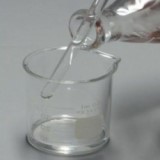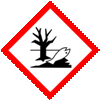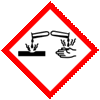| Muby Chemicals and a few more manufacturing units are in Mubychem Group, the pioneer manufacturer of Zinc Chloride Anhydrous Powder & Solution in India since 1976. Currently we have manufacturing facilities spread across Western India. No other vendor in the world knows Zinc Chloride Anhydrous & Solution any better than we do. We are exporters to all the countries across the globe. | |
|
(FDA) GMP Approved units in the group and ISO-9001 Certificate, "REACH" Registered, ISO-22000, Kosher Certified' Halal Certified, HACCP |


Zinc Chloride Solution SDS MSDS of Manufacturers, Supplier Exporters
We manufacture Zinc Chloride Solution.
Zinc Chloride Anhydrous Powder, Battery & Pharmaceutical Grade Manufacturers
Zinc Chloride Solution Manufacturers
Zinc Chloride Solution Liquid SDS, Safety Data Sheet
MSDS, Material Safety Data Sheet 11-Jul-21
1. Product Identification
Product Name & Other Names: Zinc Chloride Lye, solution, liquid.
CAS No.: 7646-85-7 for Zinc Chloride.
EINECS EC Code: 231-592-0
Molecular Weight: 136.30
Chemical Formula: ZnCl2 with water.
Relevant uses and uses advised against (if any): Industrial Manufacturing.
Suppliers: As per letterhead.
2. Hazards Identification
GHS, Globally Harmonized System Classification in accordance with 29 CFR 1910
Classification according to Regulation (EC) No 1272/2008
Acute Toxicity 4, H302
Skin corrosion/irritation Category 2, H315
Serious eye damage/eye irritation Category 1, H319
Hazardous to the aquatic environment, long-term hazard Category 2, H411
Labeling according to GHS & Regulation (EC) No 1272/2008
| GHS Label Elements  Aquatic Toxicity |
GHS Label Elements |
Signal Words: Danger
Hazard statements:
H302: Harmful if swallowed.
H315: Causes skin irritation.
H319: Causes serious eye irritation.
H411: Toxic to aquatic life with long lasting effects.
Precautionary statements:
P262: Do not get in eyes, on skin, or on clothing.
P264 Wash skin thoroughly after handling.
P270: Do not eat, drink or smoke when using this product.
P273 Avoid release to the environment.
P280: Wear protective gloves/protective clothing/eye protection/face protection.
P310: Immediately call a POISON CENTER or doctor/ physician.
P314: Get Medical advice/attention if you feel unwell.
P330: Rinse mouth.
P301+P312: IF SWALLOWED: Call a POISON CENTER or doctor/physician if you feel unwell.
P302+P352: IF ON SKIN: Wash with soap and water.
P305+ P351 + P338 IF IN EYES: Rinse cautiously with water for several minutes. Remove contact lenses, if present and easy to do. Continue rinsing.
P332+P313: If skin irritation occurs: Get medical advice/attention.
P337+P313 If eye irritation persists: Get medical advice/ attention.
P360: Rinse immediately contaminated clothing and skin with plenty of water before removing clothes.
P362: Take off contaminated clothing and wash before reuse.
P391: Collect spillage.
P404: Store in a closed container.
P501 Dispose of contents/ container to an approved waste disposal plant.
3. Composition/Information on Ingredients
Product Name & Other Names: Zinc Chloride Lye, solution, liquid.
CAS No.: 7646-85-7 for Zinc Chloride.
EINECS EC Code: 231-592-0
Percent: 30-70% Zinc Chloride in water
4. First Aid Measures
Always seek medical attention after first aid measures are provided.
Inhalation: Remove to fresh air. If not breathing, give artificial respiration. If breathing is difficult, give oxygen. Get medical attention immediately.
Ingestion: If swallowed, DO NOT INDUCE VOMITING. Give large quantities of water. Never give anything by mouth to an unconscious person. Get medical attention immediately.
Skin Contact: Immediately flush skin with plenty of water for at least 15 minutes while removing contaminated clothing and shoes. Get medical attention immediately. Wash clothing before reuse. Thoroughly clean shoes before reuse.
Eye Contact: Immediately flush eyes with plenty of water for at least 15 minutes, lifting lower and upper eyelids occasionally. Get medical attention immediately.
5. Fire Fighting Measures
Fire: Not considered to be a fire hazard.
Explosion: Not considered to be an explosion hazard.
Fire Extinguishing Media: Use water spray, alcohol-resistant foam, dry chemical, or carbon dioxide. Use means suitable for extinguishing surrounding fire.
Extinguishing Media Not recommended: None specified.
Special Information: In the event of a fire, wear full protective clothing and NIOSH-approved self-contained breathing apparatus with full face piece operated in the pressure demand or other positive pressure mode. At high temperatures under fire conditions, it may produce toxic or irritating fumes. Fire-extinguishing work is done from the windward and the suitable fire-extinguishing method according to the surrounding situation is used. Uninvolved persons should evacuate to a safe place.
6. Accidental Release Measures
Personal precautions, protective equipment, and emergency procedures: Avoid breathing dust/fumes/gas/mist/vapors/spray. Use individual protective equipment (waterproof boots, suitable protective clothing, safety glasses, etc.). Restrict unprotected personnel from the area. Prevent any contact with hot surfaces. Do not approach facing the wind. Do not touch the spilled material.
Environmental precautions: Do not let the product enter drains, soil, or water sources.
Methods and materials used for containment cleanup procedures and Storage: Do not inhale dust, vapors, mist, or gas. Avoid dust formation. Contain spilled material. Cover with an inert, non-combustible absorbent material, (e.g., sand, earth, diatomaceous earth, vermiculite). Use a shovel to put the material into a convenient waste disposal container. Finish cleaning by spreading water on the contaminated surface and allow to evacuate as per law.
7. Handling and Storage
Precautions for safe handling: Apply according to good manufacturing and industrial hygiene practices. Ensure proper ventilation. In case of insufficient ventilation, wear suitable respiratory equipment. Wash thoroughly after handling. Do not drink, eat, or smoke while handling. Avoid contact with skin, eyes, and clothing. Minimize dust generation. Avoid breathing dust/fumes/gas/mist/vapors/spray. Avoid contact with eyes, skin, and clothing. Keep container tightly closed. Avoid ingestion and inhalation. Use individual protective equipment (waterproof boots, suitable protective clothing, safety glasses, etc.). Prevent any contact with hot surfaces.
Conditions for safe storage, including any incompatibilities: Store in cool, dry, and ventilated area away from heat sources and protected from sunlight in tightly closed original container. Keep air contact to a minimum. Store protected from heat, sparks and ignition sources and incompatible materials. Avoid contact with skin and eyes. Avoid inhalation of dust/mist/vapor. Do not store with incompatible materials like strong oxidizing agents, cyanides, and sulfides.
8. Exposure Controls/Personal Protection
Airborne Exposure Limits:
OSHA Permissible Exposure Limit (PEL):
1 mg/m3 (TWA) 8H, as fume.
ACGIH Threshold Limit Value (TLV):
1 mg/m3 (TWA); 2 mg/m3 (STEL) for fume
Ventilation System: A system of local and/or general exhaust is recommended to keep employee exposures below the Airborne Exposure Limits. Local exhaust ventilation is generally preferred because it can control the emissions of the contaminant at its source, preventing dispersion of it into the general work area. Please refer to the ACGIH document, Industrial Ventilation, A Manual of Recommended Practices, most recent edition, for details.
Personal Respirators (NIOSH Approved): If the exposure limit is exceeded, a full-face piece respirator with dust/mist filter may be worn up to 50 times the exposure limit or the maximum use concentration specified by the appropriate regulatory agency or respirator supplier, whichever is lowest. For emergencies or instances where the exposure levels are not known, use a full-face piece positive-pressure, air-supplied respirator. WARNING: Air purifying respirators do not protect workers in oxygen-deficient atmospheres.
Skin Protection: Wear impervious protective clothing, including boots, gloves, lab coat, apron, or coveralls, as appropriate, to prevent skin contact.
Eye Protection: Use chemical safety goggles and/or full-face shield where dusting or splashing of solutions is possible. Maintain eye wash fountain and quick-drench facilities in work area.
Other Control Measures: Maintain good housekeeping in work area. Dust deposits on floors and other surfaces may pick up moisture and cause the surfaces to become slippery and present safety hazards. Handle in accordance with good industrial hygiene and safety practice. Wash hands after handling.
9. Physical and Chemical Properties
Appearance: The solution is clear to off-white liquid.
Odor: It is odorless.
Odor threshold: Not available.
pH: around 4
Relative density: The density depends on water content.
Melting point/freezing point: Not available.
Initial boiling point and boiling range: Not available.
Flash point: Not available.
Auto-ignition temperature: Not available.
Decomposition temperature: Not available.
Upper/lower flammability or explosive limits: Not available.
Vapor pressure: Not available.
Vapor density: Not available.
Evaporation rate: Not available.
Flammability (solid, gas): Not available.
Partition coefficient: n-octanol/water: Not available.
Solubility(ies): Soluble in water.
Viscosity: Not available.
Molecular Weight: 136.30
Chemical Formula: ZnCl2 with water.
10. Stability and Reactivity
Stability: Stable under ordinary conditions of use and storage.
Hazardous Decomposition Products: When heated to decomposition it emits toxic fumes of chlorine and zinc oxide.
Hazardous Polymerization: Will not occur.
Incompatibilities: Cyanides and sulfides, powdered zinc. When mixed with potassium, a weak explosion will occur on impact.
Conditions to Avoid: Incompatibles.
11. Toxicological Information
Oral rat LD50: 350 mg/kg.
Carcinogenicity: Not listed by ACGIH, IARC, NTP, or CA Prop 65.
Teratogenic Effects: Not available.
Mutagenic Effects: Not available.
Developmental Toxicity: Not available.
Reproductive Effects: No information available.
12. Ecological Information
Toxicity to fish: LC50 - Cyprinus carpio (Carp) - 0,4 - 2,2 mg/l - 96,0 h for ZnCl2
Toxicity to daphnia and other aquatic invertebrates: EC50 - Daphnia magna (Water flea) - 0,2 mg/l - 48 h for ZnCl2
Environmental Toxicity: Dangerous to the environment. Very toxic to aquatic organisms; may cause long term adverse effects in the aquatic environment.
Results of PBT and vPvB assessment: This substance/mixture contains no components considered to be either persistent, bioaccumulative and toxic (PBT), or very persistent and very bioaccumulative (vPvB) at levels of 0.1% or higher.
13. Disposal Considerations
Whatever cannot be saved for recovery or recycling should be managed in an appropriate and approved waste disposal facility. Processing use or contamination of this product may change the waste management options. State and local disposal regulations may differ from federal disposal regulations. Dispose of container and unused contents in accordance with law.
14. Transport Information
Land Transport DOT USA, TDG Canada & ADR/RID Europe:
Proper Shipping Name: ZINC CHLORIDE, SOLUTION
Hazard Class: 8
UN/NA: UN1840
Packing Group: III
Sea Transport IMDG/IMO:
Proper Shipping Name: ZINC CHLORIDE, SOLUTION
Hazard Class: 8
UN/NA: UN2331
Packing Group: III
Air Transport IATA/ICAO:
Proper Shipping Name: ZINC CHLORIDE, SOLUTION
Hazard Class: 8
UN/NA: UN2331
Packing Group: III.
15. Regulatory Information
USA:
SARA 311/312: Acute health hazard. See section 2.
California Proposition 65: Not listed.
Section 16 - Additional Information
DISCLAIMER: The information and recommendations set forth herein are presented in good faith and believed correct as of the date hereof. It is compiled from various sources, and it is not necessarily all inclusive nor fully adequate in every circumstance. In addition, these suggestions should not be confused with nor followed in violation of applicable laws, regulations, rules, or insurance requirements applicable. This SDS MSDS sheet is intended only as a guide to the appropriate precautionary handling of the material by a professionally trained person using this product. Individuals receiving the information must exercise their independent judgment in determining its appropriateness for a particular purpose. This shall not constitute a guarantee for any specific product features and shall not establish a legally valid contractual relationship. In no case shall our company be liable to loss or damages by the product user.Zinc Chloride SolutionManufacturers at:
MUBY CHEMICALS
MUMBAI 400009, INDIA
TEL: (OFFICE)
+91-22-23770100, +91-22-23726950, +91-22-23774610, +91-22-23723564. FAX: +91-22-23728264
Email: info@mubychem.com
USA & Canadian Customers may Call +1-773-829-5811

Copyright
and Usual
Disclaimer
is Applicable
Last
updated:
28.02.22
If you want your work to be done well, then go to a busy man.
The other one has no time.
Exporters to USA Canada UAE Europe South Africa Tanzania Kenya Uganda Egypt Nigeria Turkey Brazil Chile Argentina Dubai Cameroon Guatemala Mexico Kuwait ---
You may also check our other zinc products.
Zinc Chloride Anhydrous Powder, Battery & Pharmaceutical Grade Manufacturers
Zinc Chloride Solution Manufacturers
Zinc Sulphate Heptahydrate Manufacturers
